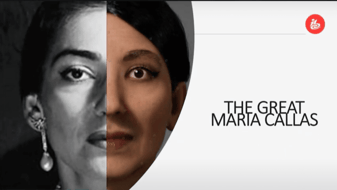
Restoring the Voice of an Opera Legend: Respeecher Gives Maria Callas a Synthetic Opera Treatment
Earlier this year, Respeecher contributed to the 2023 Accelerator project "Synthetic Humans for Entertainment & Accessibility." An objective of the project was to blur the lines between reality and synthetic media using advanced technologies to create lifelike synthetic humans.
The Challenge
To meet the demands of the challenge, Respeecher was going to need a two-pronged attack. The first requirement was to create a synthetic rendition of Maria Callas, the renowned Greek opera singer. We haven’t been focused on Maria’s signing performance, but on her speech, as we were responsible for a part where Maria handles press conference questions. This meant not only replicating her voice but also capturing the nuances and emotive qualities inherent in her speech.
The second requirement revolved around developing a photorealistic sign language interpreter capable of satisfying the demands of accessibility in broadcasting. To deliver on these objectives, every partner involved in the project was going to have to up their game within the voice and motion capture technology space, as well as in creating photorealistic 3D models. If the final result delivered anything less than enhancing the inclusivity and diversity of the media content, the project would be deemed a failure. So, while Respeecher went to work on voice cloning, the other companies spun up their video production departments.
The Solution
Respeecher, Signly, Pluxbox, and 4DR Studios worked on making this vision a reality. Throughout the process, we put multiple motion capture technologies and synthetic human creation toolkits through their paces. Respeecher specifically contributed by cloning voices, notably recreating Maria Callas' voice for interactive interview segments.
We meticulously analyzed and processed audio recordings from her archive before using our AI algorithms to create the most accurate voice model of Callas. The other teams' expertise in lip-sync technology and real-time facial expression capture played a crucial role in making the synthetic Callas both sound and appear more realistic.
The Result
When all was said and done, the project’s final result was due to the collaborative success of every team involved. The synthetic version of Maria Callas not only represented the technical advancement of the synthetic media space but also created an entirely new emotional and nostalgic experience for audiences.
Likewise, the sign language interpreter model showed off its potential for expanded use in broadcasting. Overall, the project demonstrated the potential for synthetic humans to create inclusive, emotionally resonant, and visually appealing content. The published technical paper, as part of the Final POC Results, details the key points of success and lists policy guidelines that emphasize the project's contribution to AI and sustainable production in synthetic media.
FAQ
Respeecher used advanced synthetic voice technology to meticulously analyze archival recordings, capturing the intricate nuances of Maria Callas' voice through sophisticated AI voice cloning algorithms in voice synthesis for music.
Digital representations created using synthetic voice and AI technologies that generate lifelike human models with realistic appearances, voices, and interactive capabilities for entertainment.
The photorealistic sign language model enhanced accessibility in broadcasting, providing real-time translation and creating inclusive communication solutions for diverse audiences.
By leveraging synthetic voice technologies and AI in accessibility, the project creates innovative communication methods that bridge gaps and provide new ways of experiencing historical cultural figures.
Glossary
Synthetic media
Voice cloning
Accessibility in broadcasting
Photorealistic models
Emotional AI
Opera Legend Voice Recreation: Pioneering Synthetic Media Innovation
Explore the groundbreaking world of synthetic voice technology through Respeecher's revolutionary approach to AI voice cloning in entertainment, transforming how we preserve and experience musical heritage.
The convergence of synthetic voice technologies, AI voice cloning, and advanced computational techniques represents more than a technological achievement. It symbolizes a new era of cultural preservation, communication accessibility, and artistic innovation. Respeecher's work with Maria Callas demonstrates how synthetic humans for media can resurrect and reimagine human experiences in ways previously unimaginable.
-
Historical Voice Preservation
Synthetic voice technology represents a monumental leap in cultural preservation. By capturing the intricate vocal nuances of legendary performers like Maria Callas, this technology creates an unprecedented bridge between historical artistic excellence and modern technological innovation. Researchers and music enthusiasts can now experience iconic voices with unprecedented authenticity, opening new dimensions of musical and cultural understanding.
-
Accessibility and Communication Revolution
Photorealistic sign language models and AI in accessibility are transforming communication landscapes. These advanced technologies go beyond traditional limitations, creating inclusive communication solutions that empower individuals with diverse communication needs. By breaking down barriers, these innovations ensure that media experiences become more universal, engaging, and meaningful for all audiences.
-
Emotional AI and Cultural Resonance
The intersection of emotional AI applications and synthetic voice technologies unveils profound possibilities for human expression. By capturing not just the sound, but the emotional essence of human communication, these technologies create deeply authentic experiences. From preserving historical performances to creating new forms of artistic and communicative expression, the potential for emotional and cultural connection is unprecedented.
Opera Legend Voice Recreation: Pioneering Synthetic Media Innovation
Explore the groundbreaking world of synthetic voice technology through Respeecher's revolutionary approach to AI voice cloning in entertainment, transforming how we preserve and experience musical heritage.
The convergence of synthetic voice technologies, AI voice cloning, and advanced computational techniques represents more than a technological achievement. It symbolizes a new era of cultural preservation, communication accessibility, and artistic innovation. Respeecher's work with Maria Callas demonstrates how synthetic humans for media can resurrect and reimagine human experiences in ways previously unimaginable.
-
Historical Voice Preservation
Synthetic voice technology represents a monumental leap in cultural preservation. By capturing the intricate vocal nuances of legendary performers like Maria Callas, this technology creates an unprecedented bridge between historical artistic excellence and modern technological innovation. Researchers and music enthusiasts can now experience iconic voices with unprecedented authenticity, opening new dimensions of musical and cultural understanding.
Show More
-
Accessibility and Communication Revolution
Photorealistic sign language models and AI in accessibility are transforming communication landscapes. These advanced technologies go beyond traditional limitations, creating inclusive communication solutions that empower individuals with diverse communication needs. By breaking down barriers, these innovations ensure that media experiences become more universal, engaging, and meaningful for all audiences.
Show More
-
Emotional AI and Cultural Resonance
The intersection of emotional AI applications and synthetic voice technologies unveils profound possibilities for human expression. By capturing not just the sound, but the emotional essence of human communication, these technologies create deeply authentic experiences. From preserving historical performances to creating new forms of artistic and communicative expression, the potential for emotional and cultural connection is unprecedented.
Show More







